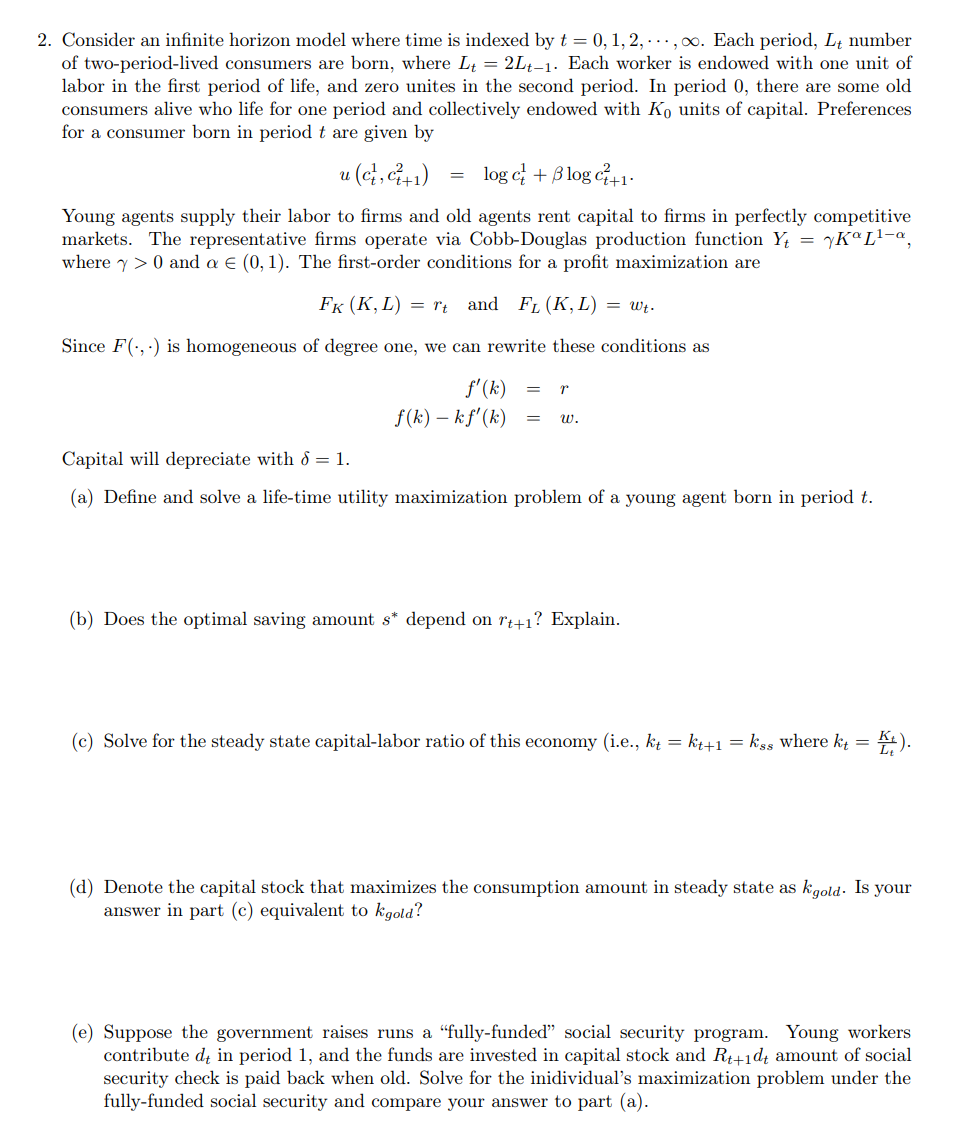(a) Define and solve a life-time utility maximization problem of a young agent born in period t. (b) Does the optimal saving amount s* depend on rt+1? Explain. (c) Solve for the steady state capital-labor ratio of this economy (i.e., kt = kt+1 = kss where kt = Kt). (d) Denote the capital stock that maximizes the consumption amount in steady state as kgold. Is your answer in part (c) equivalent to kgold? (e) Suppose the government raises runs a "fully-funded" social security program. Young workers contribute de in period 1, and the funds are invested in capital stock and Rt+1d amount of social security check is paid back when old. Solve for the inidividual's maximization problem under the fully-funded social security and compare your answer to part (a).
(a) Define and solve a life-time utility maximization problem of a young agent born in period t. (b) Does the optimal saving amount s* depend on rt+1? Explain. (c) Solve for the steady state capital-labor ratio of this economy (i.e., kt = kt+1 = kss where kt = Kt). (d) Denote the capital stock that maximizes the consumption amount in steady state as kgold. Is your answer in part (c) equivalent to kgold? (e) Suppose the government raises runs a "fully-funded" social security program. Young workers contribute de in period 1, and the funds are invested in capital stock and Rt+1d amount of social security check is paid back when old. Solve for the inidividual's maximization problem under the fully-funded social security and compare your answer to part (a).
Chapter16: Labor Markets
Section: Chapter Questions
Problem 16.12P
Related questions
Question
PLEASE HELP ME... MY ASSIGNMENT IS SO DIFFICULT... BLESS YOU...

Transcribed Image Text:2. Consider an infinite horizon model where time is indexed by t = 0, 1, 2,..., ∞. Each period, Lt number
of two-period-lived consumers are born, where Lt = 2Lt-1. Each worker is endowed with one unit of
labor in the first period of life, and zero unites in the second period. In period 0, there are some old
consumers alive who life for one period and collectively endowed with Ko units of capital. Preferences
for a consumer born in period t are given by
u (c²,c²+1)
log c + Blog +1.
Young agents supply their labor to firms and old agents rent capital to firms in perfectly competitive
markets. The representative firms operate via Cobb-Douglas production function Y = √KªL¹-a₂
where y> 0 and a € (0, 1). The first-order conditions for a profit maximization are
FK (K, L) = rt and FL (K, L) = wt.
Since F(,) is homogeneous of degree one, we can rewrite these conditions as
=
f'(k)
f(k) - kf' (k)
=
= w.
Capital will depreciate with 8 = 1.
(a) Define and solve a life-time utility maximization problem of a young agent born in period t.
(b) Does the optimal saving amount s* depend on rt+1? Explain.
(c) Solve for the steady state capital-labor ratio of this economy (i.e., kt = kt+1 = kss where kt = K₂).
(d) Denote the capital stock that maximizes the consumption amount in steady state as kgold. Is your
answer in part (c) equivalent to kgold?
(e) Suppose the government raises runs a "fully-funded" social security program. Young workers
contribute de in period 1, and the funds are invested in capital stock and Rt+1dt amount of social
security check is paid back when old. Solve for the inidividual's maximization problem under the
fully-funded social security and compare your answer to part (a).
Expert Solution
This question has been solved!
Explore an expertly crafted, step-by-step solution for a thorough understanding of key concepts.
Step by step
Solved in 6 steps with 2 images

Knowledge Booster
Learn more about
Need a deep-dive on the concept behind this application? Look no further. Learn more about this topic, economics and related others by exploring similar questions and additional content below.Recommended textbooks for you


Principles of Economics 2e
Economics
ISBN:
9781947172364
Author:
Steven A. Greenlaw; David Shapiro
Publisher:
OpenStax


Principles of Economics 2e
Economics
ISBN:
9781947172364
Author:
Steven A. Greenlaw; David Shapiro
Publisher:
OpenStax